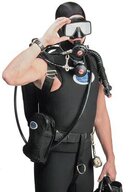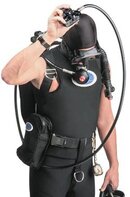THESE photographs show the routing of a long hose, although this one is 7 feet -- the only difference is that, with a 5' hose, you don't route it all the way down to your right hip but only under the arm and across the chest.
The reason to donate the regulator you are breathing is that you are sure it is working properly. The last thing you want to do is donate to an already very stressed diver, and find the reg you gave them is full of debris, or has a leaky mouthpiece or diaphragm. You, as the unstressed diver, are in a much better position to cope with something that isn't precisely as it should be (although, with a bungied octo which you have tested before you dove, the likelihood of anything being wrong is pretty darned low). In addition, when you get to more advanced diving, the regulator you are breathing is safe to breathe at the depth where you are, and you may be carrying gases that AREN'T safe at that depth.
GUE and UTD, the agencies through which I have done most of my training, both teach that you should "begin as you mean to go on". Use equipment that scales . . . that way, when you get to more advanced diving, you don't change very much at all, and all the skills you have learned continue to work. This is why people are suggesting that, if you are contemplating cave training at some point, you begin with a cave-type setup. That way, you can practice with it in open water, and some day, when you get to your cave classes, you will already be facile with the configuration you'll be required to use.






